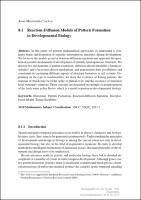Chapter 8.1 Reaction-Diffusion Models of Pattern Formation in Developmental Biology
Author(s)
Marciniak-Czochra, Anna
Contributor(s)
Antoniouk, Alexandra V. (editor)
Melnik, Roderick V. N. (editor)
Collection
European Research Council (ERC); EU collectionLanguage
EnglishAbstract
In this paper we present mathematical approaches to understand a symmetry break and formation of spatially heterogenous structures during development. We focus on the models given by reaction-diffusion equations and approach the question of possible mechanisms of development of spatially heterogeneous structures. We discuss two mechanisms of pattern formation: diffusion-driven instability (Turing instability) and a hysteresis-driven mechanism, and demonstrate their possibilities and constraints in explaining different aspects of structure formation in cell systems. Depending on the type of nonlinearities, we show the existence of Turing patterns, the maxima of which may be of the spike or plateau type, and the existence of transition layer stationary solutions. These concepts are discussed on example of morphogenesis of the fresh water polyp Hydra, which is a model organism in developmental biology.
Keywords
Mathematical Method; Statistical Method; Modeling Method; Life Sciences ApplicationDOI
10.1515/9783110288537.191ISBN
9783110273724OCN
1135845492Publisher
De GruyterPublisher website
https://www.degruyter.com/Publication date and place
Berlin/Boston, 2012Grantor
Classification
Vehicle and transport manufacturing industries
Numerical analysis
Applied mathematics
Life sciences: general issues


 Download
Download